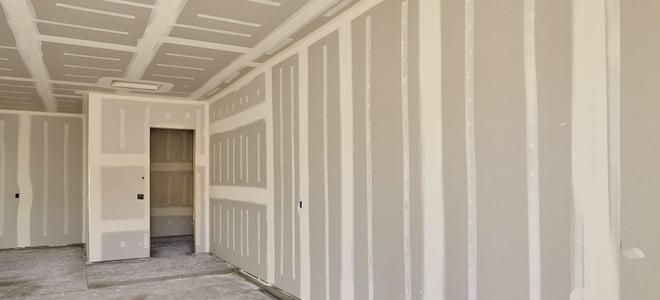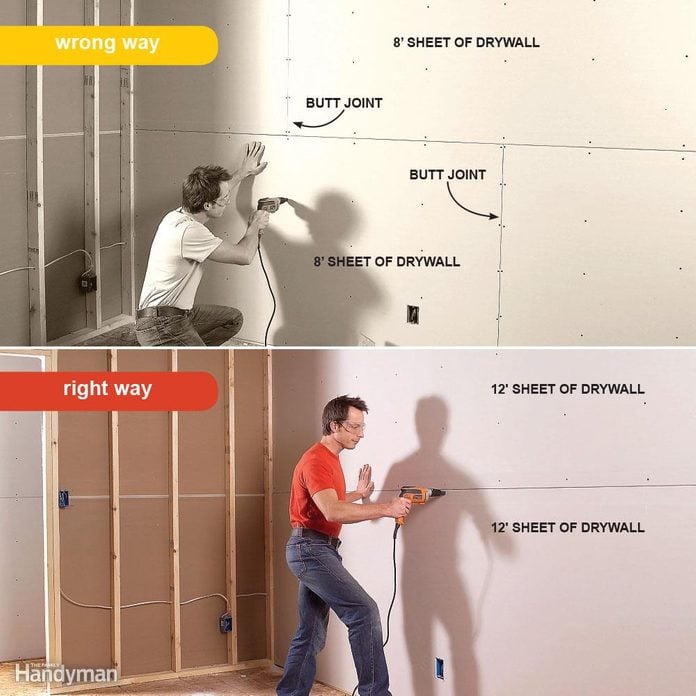- Get link
- X
- Other Apps
Start at the end with a full 16 inch bay if possible. Of exposed framing at corners.
 How To Install Drywall Lowe S Canada
How To Install Drywall Lowe S Canada
Use a 6-inch drywall knife to cover the first coat of tape and joint compound about 316 inch thick on the vertical seams.
/hammering-the-sheetrock-856783758-351b0fb78f81447ab72638943fff487e.jpg)
Hanging drywall vertically. Some will swear that hanging it horizontally is by far the easiest and standard way of doing it while others will argue that vertical hanging is better. Dont forget about the insulation. But for the majority of rooms including bathrooms hallways and areas where the walls are shorter than nine feet hanging drywall horizontally is your best bet.
Hanging Drywall Vertically. Hang the drywall vertically. If the drywall were hung vertically.
Is drywall hung vertically and horizontally. Can you lay plasterboard horizontally. Hang the drywall vertically in rooms with high ceilings like foyers and open two-story living areas.
Seams have to fall on the whole length of the frame causing you to turn it vertically. There are less chances of cracks in the drywall happening when it is spanned across more studs vs vertically. There are instances where you would consider hanging drywall vertically.
Make sure theres at least 1 in. Something important to note is that there may be fire codes that determine how you hang the drywall on commercial jobs. Make sure any insulating work and vapor barrier installation are.
This will put you on 48 inch spans again. On commercial jobs fire codes often require seams to fall on the entire length of the framing so the drywall must be hung vertically. Step 2 Use a 10-inch knife to feather the edges wide so that it blends with the wall and then lightly run the knife over the middle.
The first step to hanging drywall is to take a pencil and mark on the floor and ceiling the placement of the vertical studs. Hides uneven studs Hanging horizontally also allows the drywall to flow over the framing so that bowed studs create less of a problem. Stud walls need to be finished in some way.
If you can not do this then rip the first board down to fall center of the second stud. Changing the orientation of the drywall will just create poorer-quality finished walls. Depending on who you talk to you may receive conflicting opinions about the proper hanging of drywall.
Aesthetically a vertical install can look very nice since you dont have any butt joints between two non-beveled edges. When the walls are 9 ft. On walls that are longer than 16 ft hanging drywall vertically helps eliminate butted seams.
However on residential jobs the drywall on the walls is typically hung horizontally. As with ceilings you can hang wall panels in one of two ways horizontally or vertically. However for structural shear strength drywall is.
Those non-beveled edges create 4 long humps that can be seen with careful observation and more so with a bad mudding job. On commercial jobs fire codes often require seams to fall on the entire length of the framing so the drywall must be hung vertically. This will simplify the attachment of the drywall panels to the framing.
If a stud twists and that happens to. The solution is to inspect the framing before you start hanging drywall. Installing drywall vertically actually results in more poped seams and a weaker wall.
When done horizontally you and to offset your verticle seams so you bridge studs. Hanging drywall horizontally does as you point out place seams at a more convenient height for finishing resulting in better work but thats only part of the story. Sometimes there is benefit to hanging it horizontally as outlined in the blog but that would not change manufacture of the board.
High or less attaching the drywall horizontally can reduce the lineal footage of seams by as much as 25 over vertical attachment. Drywall is hung vertically the overwhelming majority of the time which is why the long dimension is 8 9 10 and 12 to accommodate standard ceiling heights. Hanging it vertically you must climb a step stool to reach the top corners.
For walls 9 feet high or shorter hanging the drywall horizontally has a number of benefits. Traditionally drywall is hung horizontally. Its something to keep in mind when youre measuring or figuring out how youd like to hang the drywall.
When the studs are 16 inches apart the vertical sheet should fall center of the third stud. In commercial work walls are often higher than 9 ft so it sometimes makes sense to hang drywall vertically to reduce seams. Proper Edge Support Framing at inside corners is often inadequate or lacking altogether making it impossible to fasten the edge of the drywall left.
This helps to stiffen the studs and make a stronger wall. Before moving on its essential to remember insulation when applying.
 How Drywall Works Home Repairs Diy Home Improvement Home Diy
How Drywall Works Home Repairs Diy Home Improvement Home Diy
Tips To Hang Drywall Vertically Or Horizontally
 Hanging Drywall Vertically Doityourself Com
Hanging Drywall Vertically Doityourself Com
/sheetrock-hangers-157509604-583874c25f9b58d5b1aa6c07.jpg) Professional Tips For Hanging Drywall
Professional Tips For Hanging Drywall
 Home Improvement Q A Vertical Or Horizontal For Basement Drywall Baileylineroad
Home Improvement Q A Vertical Or Horizontal For Basement Drywall Baileylineroad
/hammering-the-sheetrock-856783758-351b0fb78f81447ab72638943fff487e.jpg) Easy Solutions To Common Drywall Problems
Easy Solutions To Common Drywall Problems
 Horizontal Vs Vertical Drywall Fine Homebuilding
Horizontal Vs Vertical Drywall Fine Homebuilding
Horizontal Or Vertical Drywall Application
Eliminating Problems With Drywall Butted Seams This Is Drywall
 Diy Q A Home Improvement Database And Library
Diy Q A Home Improvement Database And Library
 7 Drywall Installation Mistakes You Ve Probably Made Before Family Handyman
7 Drywall Installation Mistakes You Ve Probably Made Before Family Handyman
Can Drywall Be Installed Vertically On Walls Quora
 Ppt Drywall Installation Powerpoint Presentation Free Download Id 2174417
Ppt Drywall Installation Powerpoint Presentation Free Download Id 2174417
/drywallanatomy1-56a49bfd5f9b58b7d0d7cd42.jpg)
Comments
Post a Comment